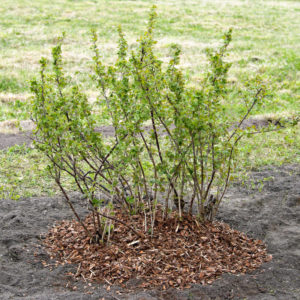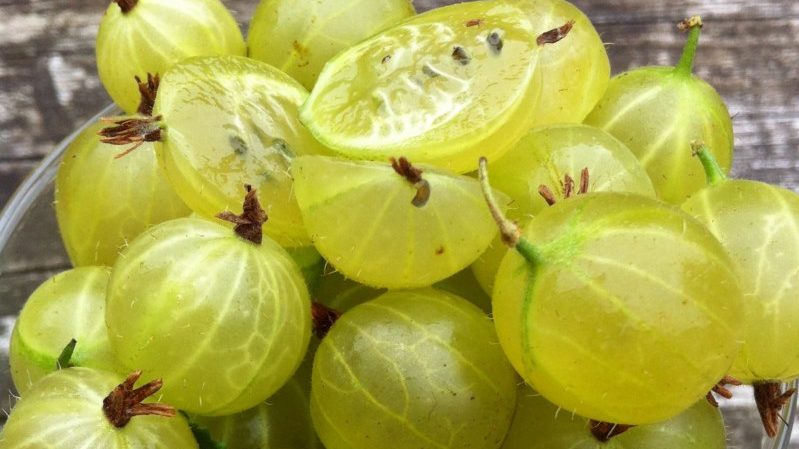How to prune gooseberries in the spring for a good harvest
A rich gooseberry harvest is the dream of any gardener. This delicious berry has been grown since ancient times specifically to be served at the royal table. Since then, gooseberry jam has been called royal.
However, in growing gooseberries are a capricious culture. With proper care, the plant can bear fruit abundantly and for a long time, up to 30-40 years, but it is worth starting it a little, and there will be few berries. On average, up to 10 kg of berries can be harvested from one bush. One of the most important maintenance items is pruning the shoots. To have a good harvest, it is necessary to prune the shoots in the fall and spring.
The content of the article
Do I need to cut gooseberries in spring and what are the advantages
During the season, the bush gives a lot of shoots, gradually grows and loses its fertility. Shoots absorb moisture and take nutrients from the ground when feeding. The shrub becomes vulnerable to pests and diseases. To prevent this from happening, the plant is regularly pruned.

Spring pruning of gooseberries has its own goals:
- Wellness. When pruning young shoots, moisture and nutrients are retained for the main bush. This makes the plant strong and fertile.
- Productivity. If pruning is done correctly and in a timely manner, the harvest ripens faster, the berries have a sweet taste and retain their beneficial properties.
- Aesthetics. Correctly cut gooseberries decorate the site, and numerous sluggish and diseased shoots give it an ugly look. After pruning, the crown of the plant is transformed.
The lack of spring pruning is only in its untimeliness. In this case, the bush runs the risk of getting sick or stop bearing fruit. It is possible that he may die.
Spring Pruning Benefits:
- increased productivity;
- healthy roots;
- reducing the risk of disease and insect pests;
- prevention of unauthorized rooting of the plant;
- beautiful bush shape.
How to prune gooseberries in the spring for a good harvest
It is important to know how to prune gooseberries in the spring, especially for novice gardeners. Cropping is a necessary element leaving, because the bush must receive all the necessary conditions for the yield.
What you need to trim
To trim gooseberry bushes, two main tools are used:
- Secateurs... It removes thin and dry stems at the edges of the plant.
- Lopper... It is used for sturdy branches that sit in the middle of the bush and cannot be cut with pruners.

When buying, choose tools with well-sharpened knives. Blunt knives can only damage the plant, which will have a bad effect on its yield.
The weight of the inventory is also important. A heavy tool is inconvenient to use.
The handle of any tool must be rubberized. If your hand slips, you run the risk of injury while working.
When choosing a model, it is not worth saving. A low-quality cheap tool breaks down quickly when pruning powerful branches.
Another item you need is sturdy gloves to avoid hurting your hands on the thorns.
Cutting scheme and algorithm

It is believed that the size of the crown affects the yield, and the more massive the bush, the more fertile it is.... In reality, this is not the case, only correct pruning will give the plant the ability to produce many berries.
The optimal time to start spring pruning in the middle lane is early March. In different regions, the dates are shifted depending on climatic conditions.
In the first year of life a bush is formed, and then regularly maintain this form. Formation is essential for good plant development.
In the first year, the shoots grow intensively and already in the middle of summer change color from green to brown. In autumn, young stems become hard, and the next year, shoots appear on them. These branches of the first order form the basis of the bush.
Every year, an increase in length from 10 to 30 cm is formed on them. Over the summer, the growth acquires bark and becomes a branch of the second order. In turn, new shoots begin to appear from it, and by autumn they also become branches, but of the third order. Further, the shoots grow stronger, up to the fourth and fifth orders.
The branches of the first, second and third order are more prolific. With regular pruning, these shoots are constantly renewed, which contributes to the yield. It is recommended to remove branches of the fourth and fifth order completely.
Also, due to the specific structure of the root system, gooseberries form a lot of horizontal root growth. It is also removed, since it takes away the strength of the plant.
Cutting off excess shoots is also necessary because they retard the flow of air, and the gooseberry loves good aeration and abundant sun.
Reference. The optimal number of main stems in gooseberry bushes is 8-10 pieces.
The classic way of trimming
Cut off the bushes from the middle.
In the first year of life, the plants remove all root shoots, leaving five buds on the cut branches.
In the second year, root shoots are removed and healthy branches are left.
For 3-4 years, last year's branches are removed by a third and 4-5 new shoots are preserved. After pruning, no more than 15 branches are left.
In the fifth or seventh year of life, branches over five years old and all root shoots are cut off. Up to 20 strong, healthy branches are left on the bush.
Stamp trimming method
With this method, one healthy central shoot is left as a basis (trunk) and branches extending from it are preserved. All other shoots are removed using the classical method. The crown of the plant is pruned.
The formed trunk needs support, so the bush at the base is fixed using an ordinary wooden stick.
With this method, a lot of light and heat is supplied to the bush, its yield increases, and the area on the site is saved. At the same time, the plant's immunity and frost resistance decrease, it ages faster.
Also, gooseberries need pruning in the fall so that there is a lot of harvest.
It is interesting:
Sweet and juicy gooseberry variety Yubilyar
The sweetest and largest gooseberry: description of varieties
Leaving after spring pruning
Trimming alone is not enough to get a good harvest. After this procedure, the gooseberry requires further care.

Cutting site processing
Cutting sites are processed for prevention purposes. A fresh cut can be attacked by pathogens.
Before processing the cut, it must be dried. Experienced gardeners do not recommend handling wet cuts.
Garden lime is most often used for processing. It is a product of processing limestone, carbonates and chalk. It is used in horticulture to improve soil fertility and protect plants from pests and diseases.
You can also process the cut with a garden pitch. It is a mixture of resin and bee products. Var prevents the appearance of fungi and bacteria in the cut points and prevents the juice from flowing out.
The processing will be of high quality if:
- smooth the cut with a garden knife;
- clean the cut site;
- apply the product gently with a spatula or fingers.
Top dressing
The first gooseberry feeding after pruning, it is carried out in April. Beginning after swelling of the kidneys.
Two-year-old plants need 40-60 g of urea (carbamide) per bush.It contains nitrogen, which gooseberries need in spring. Urea granules are mixed with ash and applied to the soil under the bush.
Adult plants are fed with a more complex composition. Organic and mineral fertilizers are mixed.
Composition for the first feeding:
- superphosphate - 20 g;
- urea - 10 g;
- potassium - 10 g.
These substances are diluted in one bucket of water. Poultry manure or slurry is also used at the rate of 1 kg of manure per bucket. An alternative version of this top dressing is 4 kg of compost.
The culture is fed the second time during the flowering period.
Composition for the second feeding:
- 1/2 bucket of humus;
- 1/2 bucket of rotted manure;
- 20 g of potassium fertilizer.
The composition is introduced into the soil at a radius equal to the size of the plant's crown.
The third feeding is carried out after flowering in May. The plants are watered with a mixture of mullein and water in a 1: 5 ratio.
It is interesting:
General characteristics and description of varieties of hairy gooseberries
High-yielding frost-resistant gooseberry variety Masheka
The best gooseberry varieties for the Urals and Siberia: description and reviews
Watering, loosening and mulching the soil
To prepare the plant for fruiting, it is necessary to saturate the soil with moisture and oxygen.
Since gooseberries do not require abundant watering, they moisten the soil during dry weather. But on the day of pruning, the plants are necessarily sprayed with boiling water. This is necessary to awaken the bush and destroy pests.
Watering one bush requires 2-3 buckets of 10 liters.
During flowering, up to 50 liters of water are consumed per bush. The plant needs water during this period in order to form fruits.
After watering, loosen the soil under the bushes. A hoe is best suited for these purposes. It is immersed in the ground by 7-8 cm. When loosening, oxygen is provided to the roots of the plant and the permeability of the soil is increased.
In order to retain moisture in the soil as much as possible and slow down the growth of weeds, after loosening it is covered with mulch along the trunk circle. Sawdust, peat or straw can be used as mulch. Crushed tree bark is also used. Sprinkle the mulch in such a layer that the soil is hidden under it.
Reference. Gooseberries usually begin bearing fruit from the age of three.

Conclusion
Caring for gooseberries is not easy. It should not be allowed to overgrow, this will have a bad effect on the harvest of berries and reduce their taste and quality. Therefore, pruning the bushes is an important component of care. It must be carried out in a timely manner and correctly, taking into account the age of the bushes and the degree of their overgrowth.
Also, for cut bushes, you need nutritious soil, enriched with fertilizers and sufficient moisture. Observing these rules, you can enjoy the abundance of berries, which will be enough for fresh consumption, making jam, compotes and various fruit delicacies.